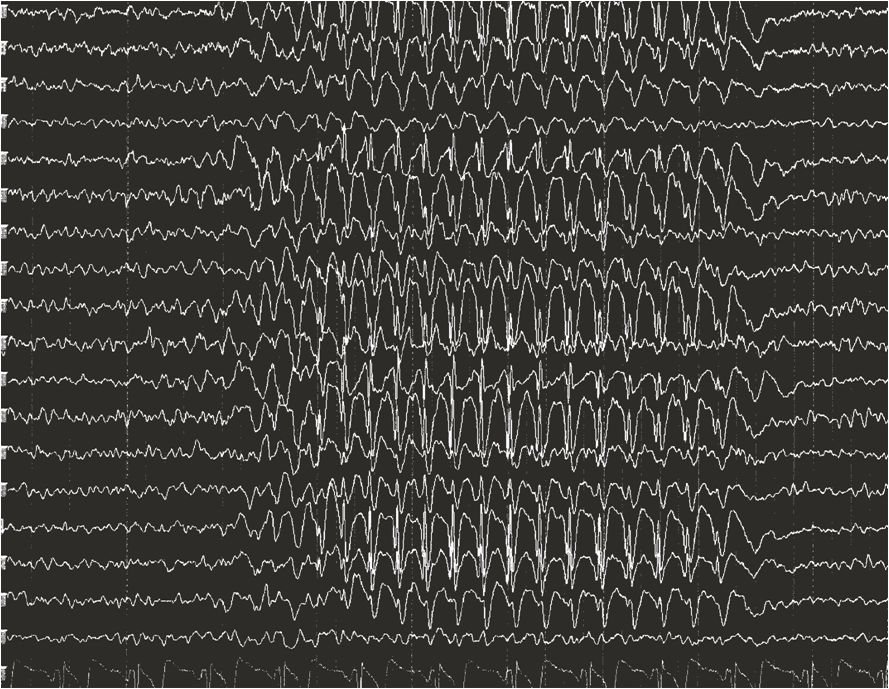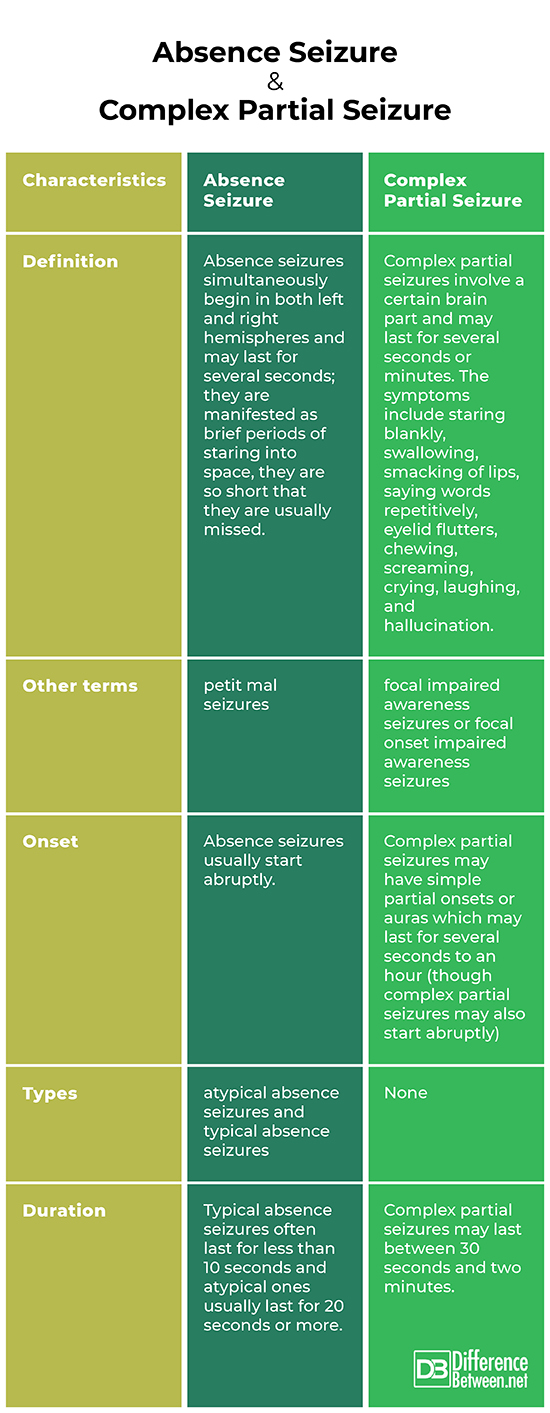Difference Between Absence Seizure and Complex Partial Seizure
Absence seizures and complex partial seizures involve staring blankly and impairment of consciousness. Their diagnoses may be confirmed through brain imaging technology such as electroencephalogram (EEG) and magnetic resonance imaging (MRI) and they both may be treated with medications. Specifically, absence seizures simultaneously begin in both left and right hemispheres and may last for several seconds while complex partial seizures involve a certain brain part and may last between 30 seconds and two minutes. The following discussions further delve into their distinctions.

What is Absence Seizure?
Absence seizures, also known as petit mal seizures, are manifested as brief periods of staring into space; they are so short that they are usually missed. With immediate recovery, they often only affect present awareness; hence, they are often mistaken as simply not paying attention or daydreaming. The usual first clue is when affected children have difficulties in school; they may often have incomplete work or miss important instructions. During a seizure, they are not aware of their surroundings and will not respond if someone is talking to them and they stop speaking in the middle of a conversation and this may appear like a mere pause to others. After a seizure, they may simply seem confused and lose track of what has occurred.
Similar with other types of seizures, they are attributed to short aberrant electrical activity in the brain. Absence seizures are described as generalized onset seizures, this means that they simultaneously begin in both left and right hemispheres. They are most common in children, especially from 4 to 14 years old and the seizures may disappear by 18 years old. The frequency of the seizures varies a lot and seizure medicines such as lamotrigine, ethosuximide, and valproic acid may be prescribed (Kiriakopoulous & Osborne, 2019).
Two Types of Absence Seizures
1. Typical Absence Seizures
As what its name suggests, typical absence seizures are more common, they often last for less than 10 seconds. An individual with this condition may just have a blank look, his or her eyelids may flutter and his or eyes may turn upwards.
2. Atypical Absence Seizures
As compared to typical absence seizures, atypical ones last longer, usually 20 seconds or more. They may also have slower onset and offset; they may involve repetitive blinking, smacking of lips, chewing movements, and rubbing of fingers (or other hand motions).

What is Complex Partial Seizure?
Complex partial seizures (CPS), also known as focal impaired awareness seizures or focal onset impaired awareness seizures, are focal seizures related with consciousness impairment which start in one brain hemisphere (Kumar & Sharma, 2020). Usually, the affected brain part is the temporal lobe. These seizures usually occur for a few minutes and start abruptly; they may last between 30 seconds and two minutes. The symptoms include staring blankly, swallowing, smacking of lips, saying words repetitively, eyelid flutters, chewing, screaming, crying, laughing, and hallucination. People who have just experienced a complex partial seizure feel confused and are not aware of the seizure. This often occurs in individuals with cerebral palsy; other conditions association with complex partial seizure include anxiety, depression, autism, neurofibromatosis, and other neurological conditions. Also, the triggers include high fever, flashing lights, low blood sugar level, and reactions to certain medications (Wells, 2017).
Though it can happen usually without a warning, an aura or a simple partial seizure may signal that a bigger seizure will occur. Auras include visual changes (i.e., slowing spreading spots, distortion of objects’ sizes or shapes, and seeing bright lights), auditory and olfactory hallucinations, feelings of numbness, tingling sensations, anxiety, and nausea. They may last for several seconds to an hour before a seizure (Healthwise, 2020).
The diagnosis is confirmed with an electroencephalogram (EEG) report; potential causes may be identified through a CT scan, an MRI, a blood test, and/or a neurological exam. The treatment options include antiepileptic drugs, vagus nerve stimulation, dietary changes (ketogenic diet), and surgery (Wells, 2017).
Difference between Absence Seizure and Complex Partial
Definition
Absence seizures simultaneously begin in both left and right hemispheres and may last for several seconds; they are manifested as brief periods of staring into space, they are so short that they are usually missed.
On the other hand, complex partial seizures involve a certain brain part and may last for several seconds or minutes. The symptoms include staring blankly, swallowing, smacking of lips, saying words repetitively, eyelid flutters, chewing, screaming, crying, laughing, and hallucination.
Other Terms
Absence seizures are also known as petit mal seizures while complex partial seizures, are also known as focal impaired awareness seizures or focal onset impaired awareness seizures.
Onset
Absence seizures usually start abruptly while complex partial seizures may have simple partial onsets or auras which may last for several seconds to an hour (though complex partial seizures may also start abruptly).
Types
The two types of absence seizures are atypical absence seizures and typical absence seizures. In comparison, complex partial seizures are a type of focal onset seizures.
Duration
Typical absence seizures often last for less than 10 seconds and atypical ones usually last for 20 seconds or more. As for complex partial seizures, they may last between 30 seconds and two minutes.
Absence Seizure vs Complex Partial Seizure

Summary
- Absence seizures simultaneously begin in both left and right hemispheres and may last for several seconds; they are manifested as brief periods of staring into space, they are so short that they are usually missed.
- Complex partial seizures involve a certain brain part and may last for several seconds or minutes. The symptoms include staring blankly, swallowing, smacking of lips, saying words repetitively, eyelid flutters, chewing, screaming, crying, laughing, and hallucination.
- Typical absence seizures often last for less than 10 seconds and atypical ones usually last for 20 seconds or more while complex partial seizures may last between 30 seconds and two minutes.
- Difference Between Hematoma and Melanoma - February 9, 2023
- Difference Between Bruising and Necrosis - February 8, 2023
- Difference Between Brain Hematoma and Brain Hemorrhage - February 8, 2023
Search DifferenceBetween.net :
Leave a Response
References :
[0]Cedars-Sinai (2021). Complex partial seizures. https://www.cedars-sinai.org/health-library/diseases-and-conditions/c/complex-partial-seizures.html
[1]Healthwise (2019). Aura and Seizures. Michigan Medicine. https://www.uofmhealth.org/health-library/tm6354
[2]Kiriakopoulos, E. & Osborne, P. (2017). Types of seizures. Epilepsy Foundation. https://www.epilepsy.com/learn/types-seizures
[3]Kumar, A. & Sharma, S. (2020). Complex partial seizure. NCBI. https://www.ncbi.nlm.nih.gov/books/NBK519030/
[4]Wells, D. (2017). Complex partial seizures. Healthline. https://www.healthline.com/health/complex-partial-seizures
[5]Image credit: https://live.staticflickr.com/47/157243306_ec7fc3226a_b.jpg
[6]Image credit: https://commons.wikimedia.org/wiki/File:EEG_Absence_seizure.png
